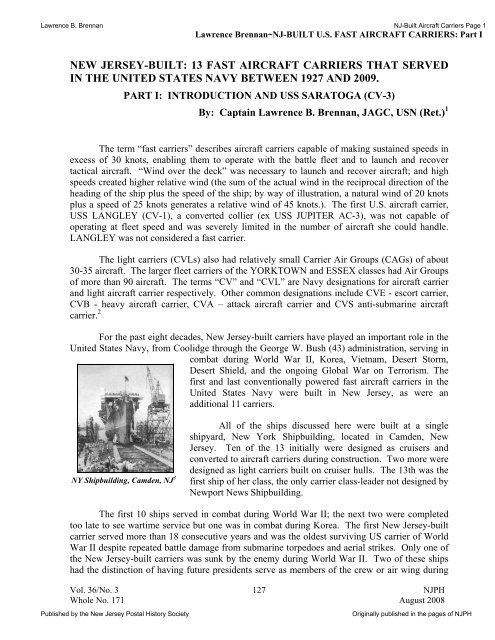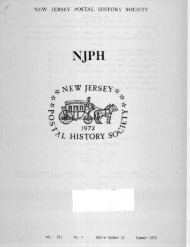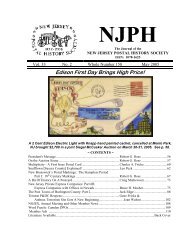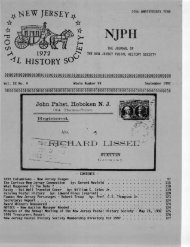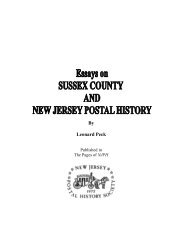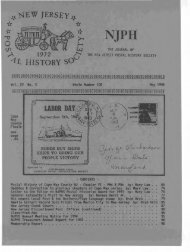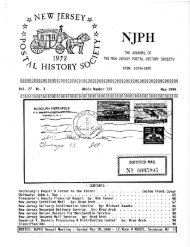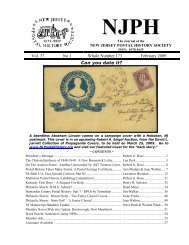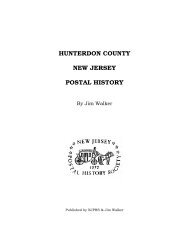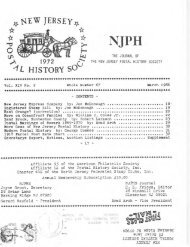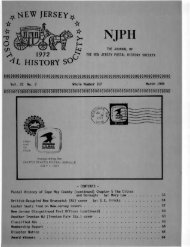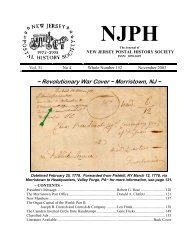By Captain Lawrence B. Brennan, U.S. Navy (Ret.) - New Jersey ...
By Captain Lawrence B. Brennan, U.S. Navy (Ret.) - New Jersey ...
By Captain Lawrence B. Brennan, U.S. Navy (Ret.) - New Jersey ...
You also want an ePaper? Increase the reach of your titles
YUMPU automatically turns print PDFs into web optimized ePapers that Google loves.
<strong>Lawrence</strong> B. <strong>Brennan</strong> NJ-Built Aircraft Carriers Page 1<br />
<strong>Lawrence</strong> <strong>Brennan</strong>~NJ-BUILT U.S. FAST AIRCRAFT CARRIERS: Part I<br />
NEW JERSEY-BUILT: 13 FAST AIRCRAFT CARRIERS THAT SERVED<br />
IN THE UNITED STATES NAVY BETWEEN 1927 AND 2009.<br />
PART I: INTRODUCTION AND USS SARATOGA (CV-3)<br />
<strong>By</strong>: <strong>Captain</strong> <strong>Lawrence</strong> B. <strong>Brennan</strong>, JAGC, USN (<strong>Ret</strong>.) 1<br />
The term “fast carriers” describes aircraft carriers capable of making sustained speeds in<br />
excess of 30 knots, enabling them to operate with the battle fleet and to launch and recover<br />
tactical aircraft. “Wind over the deck” was necessary to launch and recover aircraft; and high<br />
speeds created higher relative wind (the sum of the actual wind in the reciprocal direction of the<br />
heading of the ship plus the speed of the ship; by way of illustration, a natural wind of 20 knots<br />
plus a speed of 25 knots generates a relative wind of 45 knots.). The first U.S. aircraft carrier,<br />
USS LANGLEY (CV-1), a converted collier (ex USS JUPITER AC-3), was not capable of<br />
operating at fleet speed and was severely limited in the number of aircraft she could handle.<br />
LANGLEY was not considered a fast carrier.<br />
The light carriers (CVLs) also had relatively small Carrier Air Groups (CAGs) of about<br />
30-35 aircraft. The larger fleet carriers of the YORKTOWN and ESSEX classes had Air Groups<br />
of more than 90 aircraft. The terms “CV” and “CVL” are <strong>Navy</strong> designations for aircraft carrier<br />
and light aircraft carrier respectively. Other common designations include CVE - escort carrier,<br />
CVB - heavy aircraft carrier, CVA – attack aircraft carrier and CVS anti-submarine aircraft<br />
carrier. 2 For the past eight decades, <strong>New</strong> <strong>Jersey</strong>-built carriers have played an important role in the<br />
United States <strong>Navy</strong>, from Coolidge through the George W. Bush (43) administration, serving in<br />
combat during World War II, Korea, Vietnam, Desert Storm,<br />
Desert Shield, and the ongoing Global War on Terrorism. The<br />
first and last conventionally powered fast aircraft carriers in the<br />
United States <strong>Navy</strong> were built in <strong>New</strong> <strong>Jersey</strong>, as were an<br />
additional 11 carriers.<br />
NY Shipbuilding, Camden, NJ 3<br />
All of the ships discussed here were built at a single<br />
shipyard, <strong>New</strong> York Shipbuilding, located in Camden, <strong>New</strong><br />
<strong>Jersey</strong>. Ten of the 13 initially were designed as cruisers and<br />
converted to aircraft carriers during construction. Two more were<br />
designed as light carriers built on cruiser hulls. The 13th was the<br />
first ship of her class, the only carrier class-leader not designed by<br />
<strong>New</strong>port <strong>New</strong>s Shipbuilding.<br />
The first 10 ships served in combat during World War II; the next two were completed<br />
too late to see wartime service but one was in combat during Korea. The first <strong>New</strong> <strong>Jersey</strong>-built<br />
carrier served more than 18 consecutive years and was the oldest surviving US carrier of World<br />
War II despite repeated battle damage from submarine torpedoes and aerial strikes. Only one of<br />
the <strong>New</strong> <strong>Jersey</strong>-built carriers was sunk by the enemy during World War II. Two of these ships<br />
had the distinction of having future presidents serve as members of the crew or air wing during<br />
Vol. 36/No. 3<br />
127<br />
NJPH<br />
Whole No. 171 August 2008<br />
Published by the <strong>New</strong> <strong>Jersey</strong> Postal History Society<br />
Originally published in the pages of NJPH


